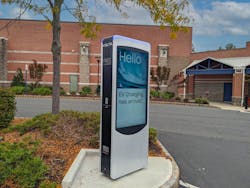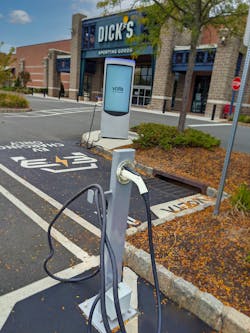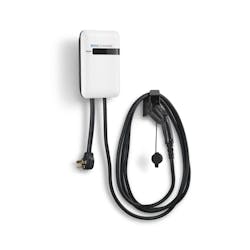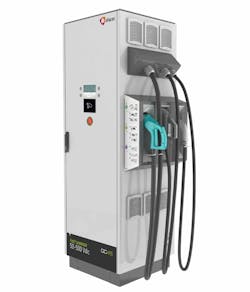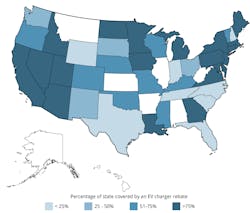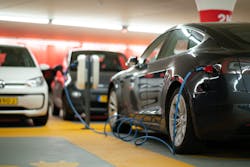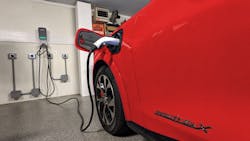Electric vehicle (EV) sales are projected to grow dramatically, with millions more cars coming to the roads in the next few years. But where will these cars charge up? At the time of this writing, the United States has roughly 168,000 gas stations but only 44,417 publicly available EV charging stations. That means the infrastructure has a long way to go to catch up.
This trend presents a unique opportunity for electrical distributors and contractors. Both homeowners and businesses will be installing EV charging stations in the coming years to accommodate their new electric cars. Homeowners may seek the convenience of rapidly charging their car at home. Businesses will need a way to keep their electric fleet or their employees' cars charged up. Places like hotels, restaurants, and retail stores might need to add EV chargers to increase traffic and keep customers happy.
As contractors and distributors start to focus on opportunities in the EV charging market, rebates will likely be a key to their success. The cost of installing an EV charger can add up for a homeowner or a business, making it harder to get customers to install these stations. As a result, many organizations across the country are providing rebates, incentives, and tax credits for installing EV chargers. While many in the industry may be familiar with rebates for equipment such as lighting or HVAC that have been around for years, EV charger rebates can work a little differently.
Understanding the types of EV chargers available
To fully understand rebates and incentives for EV chargers, it's essential to review the terminology often used. Technically, what most people call "EV chargers" are actually "Electric Vehicle Supply Equipment" (EVSE). These stations convert power to a format that the electric vehicle can accept; the charger itself is built into the car. That being said, the most popular term for these units is "EV chargers." Broadly speaking, EV chargers fall into three categories:
Level 1 charger: 120V
A Level 1 EV charger plugs into a standard outlet and is usually the type of charger that comes with most EVs. Usually, a Level 1 charger can add two to three miles to a car for each hour they're connected. These units are primarily used in residential applications.
Level 2 charger: 240V
A Level 2 EV charger lets users charge up their electric vehicle around five times faster. These chargers use 240V and can be hardwired or use a NEMA 14-50 plug. They add between 12 to 60 miles to a battery each hour. These chargers are the most popular in both residential and commercial applications.
Level 3 charger: 400V or more
A Level 3 EV charger is the fastest type of EV charger. They're also called fast chargers, DCFC chargers, or DC fast chargers. These units typically use 400V or more and add 150 miles to a battery in an hour. These are limited to commercial applications.
Sources of EV charger incentives
Rebates and incentives for EV chargers can come from a variety of sources. The most widely known program, the Federal 30C Tax Credit, expired at the end of 2021, but more opportunities are available. Approximately 57% of the country is also covered by an additional rebate, incentive, or grant for EV chargers (Map).
Rebates for commercial EV chargers
Currently, 51% of the United Sates has a rebate for the installation of a commercial EV charger, but eligibility can vary depending on the type.
Level 2 EV chargers are the most commonly incentivized. Almost half of the United States (49%) has a rebate available for this type of equipment. While there is quite a range of dollar amounts, the average rebate for a Level 2 charger is $1,731.
Level 3 commercial EV charger rebates are less popular, with only 38% of the country having an additional incentive available. However, because these charging stations are much more expensive than Level 2 chargers, the incentive can be significantly higher. On average, the rebate for a Level 3/DC fast charger is $37,878.
Rebates for residential EV chargers
When it comes to EV chargers for home use, approximately 30% of the country has a rebate or incentive available. Most of these incentives are for Level 2 chargers. That makes sense because most EVs come with Level 1 chargers when purchased. On average, the rebate is $473 for this type of charger, but it can vary anywhere from $50 to $2,000.
Important factors to consider
Make sure the charger you purchase meets the program's requirements. For example, some rebate programs require that the charger is networked (usually with Wi-Fi) to report data back. Other programs require that the charger uses a specific rate code or billing plan.
The specific make and model of an EV charger can also matter. Some programs will require a particular brand of charger. Others may have a list of approved equipment. These types of programs are in the minority, with only around 5% of all rebates specifying certain models or brands.
When installing multiple chargers, it's important to look for any rebate caps per site. For example, some programs will only allow a certain number of chargers; others will cap the incentive at a specific dollar amount per site.
Some EV charger rebate programs have limited funding that goes very quickly. This issue will likely be exacerbated in the future as EVs grow in popularity. Pay attention to deadlines, and make sure to adhere to them. Research the options early on to see if a program currently has a waitlist or will be re-opening in the future.
How long will EV charger rebates last?
It's hard to tell how long incentives for EV chargers will last. Historically, rebates for other technologies like lighting, HVAC, and other efficient equipment have been around for many years. But EV chargers are different; they don't provide energy efficiency benefits. Instead, they offer the utility a new way to make revenue. In theory, there will eventually be enough chargers to meet the demand, and these rebates may no longer be needed. Therefore, it's very likely that early adopters of EV charging will be the only ones to benefit from rebates.
Randy Young is the operations manager at BriteSwitch, a company that specializes in finding and capturing rebates for businesses. He can be reached at [email protected].
About the Author
Randy Young
Director of Marketing and Data Solutions
Randy Young is the director of marketing and data solutions at BriteSwitch, a company that specializes in finding and capturing rebates for businesses. He can be reached at [email protected].
